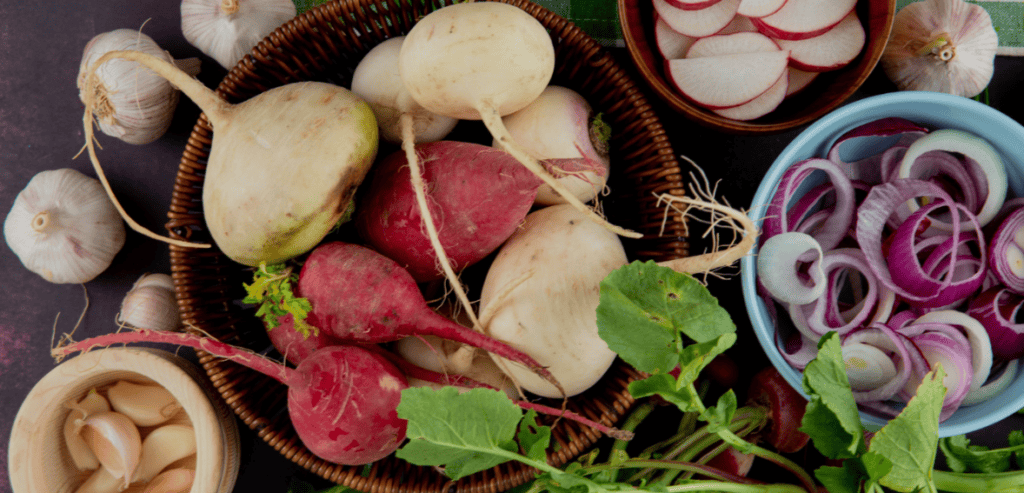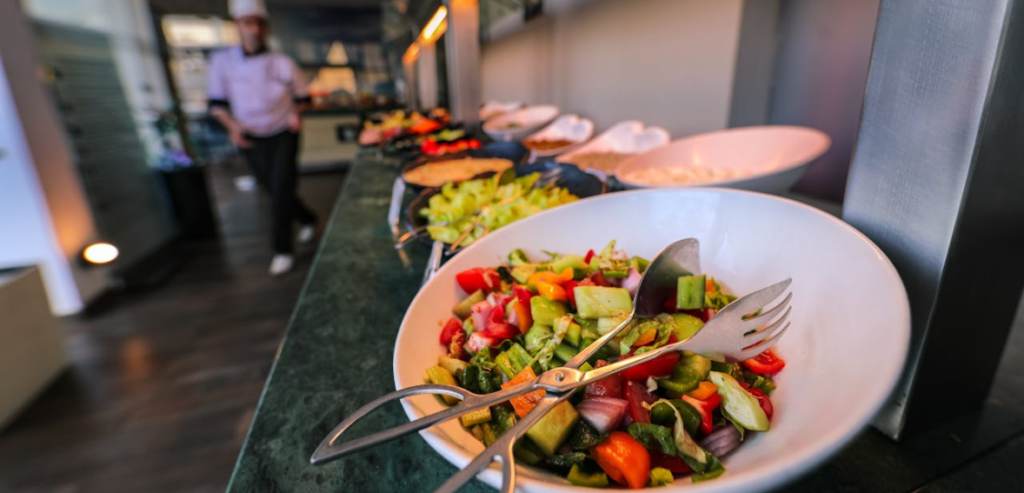
By Jermaine Thomas September 23, 2025
Food is at the heart of any celebration and catering menus are a reflection of creativity and seasonality. Whether it’s a winter wedding or a summer garden party the best food often comes from using fresh, local produce at its peak. This ensures flavour and sustainability and cost effectiveness. Chefs and catering companies know that seasonal dishes make an impact and diners love meals that highlight what’s in season at that time of year. With a seasonal ingredient guide catering can go from routine to a culinary journey through the year.
Seasonality has always influenced food traditions but today’s catering world takes it further by creating menus specifically for the time of year. In the colder months root vegetables and hearty greens dominate and winter catering menus are warm and comforting. As the months roll on and the sun shines longer the colours of berries, tomatoes and herbs shine in summer catering menus. These thoughtful seasonal changes show off the versatility of ingredients and ensure the food feels right for the occasion and setting of the event.
The Value of Seasonal Ingredients in Catering
Seasonal cooking is about more than just freshness; it’s about harmony. A dish with produce at its peak has natural flavour that no imported or out of season substitute can replicate. For caterers this means every event is an opportunity to showcase the bounty of the local harvest. A well designed seasonal ingredient guide helps chefs plan in advance so they use what’s in abundance and affordable at the time. This also strengthens ties with local farmers and suppliers and reduces costs.
Guests notice the difference too. A summer salad or winter stew resonates because it feels right for the season. Pairing menus with the time of year enhances the whole dining experience and makes it memorable and thoughtful. Caterers who use winter menus or summer menus show they can create dishes that not only taste good but also fit the moment. In doing so they prove they are professionals who understand food and the emotions it carries.
Winter Root Vegetables and Comfort-Focused Menus
When the days get short and cold, people turn to warm, filling foods. Root vegetables like carrots, parsnips, beets and potatoes become staples of winter catering menus. These ingredients are easy to store and abundant so lend themselves to roasts, soups and hearty sides. Their earthy flavours create dishes that are comforting and nourishing, just like winter gatherings. For caterers, root vegetables are versatile; roasted with herbs, blended into velvety soups or even into desserts like beet cake.
Using a seasonal ingredient guide, chefs can pair these root vegetables with other winter stars like kale, cabbage and squash. Together they create menus that are rustic yet refined. Guests expect warmth in winter and menus built around these flavours deliver. Beyond taste, winter ingredients provide nutritional value that supports health in the colder months. When caterers design winter catering menus with root vegetables at the core, they offer both comfort and creativity, elevating seasonal dining into an experience that feels both familiar and special.
Fresh Greens and Citrus for Winter Brightness
While winter menus can be rich and hearty, they also need a burst of freshness. Citrus fruits like oranges, lemons and grapefruits are at their peak in winter and are the perfect companions to heavier dishes. Caterers who include citrus in their winter catering menus strike a balance between comfort and refreshment. Citrus can be used in salads, glazes for roasted meats or even in desserts like tarts and custards, adding a bright flavour that lifts the whole menu.
Pairing citrus with hardy greens like kale or spinach adds texture and vibrancy. Using a seasonal ingredient guide, caterers can create dishes that surprise guests with freshness in the middle of winter. This is important because it stops meals from feeling too heavy and provides variety for different palates. Whether it’s a citrus dressed salad or a lemon roasted chicken, these elements show how winter catering menus can be diverse, colourful and exciting even in the coldest months of the year.
Spring’s Transition: Tender Greens and Fresh Herbs
As winter gives way to spring, menus shift from heaviness to freshness. Early spring brings tender greens, peas, asparagus, and fragrant herbs like mint and parsley. These ingredients signal renewal and freshness, perfectly suited for events that celebrate beginnings, such as weddings or corporate launches. Caterers use a seasonal ingredient guide to adjust quickly, swapping root vegetables for lighter, crisp flavors that appeal to diners eager for change.
In spring, dishes highlight subtlety rather than intensity. Light soups, fresh salads, and herb-infused mains dominate. Caterers can experiment with pairings such as asparagus with lemon or peas with mint, creating meals that feel vibrant and delicate. Spring also introduces edible flowers that not only enhance flavor but also add visual appeal, perfect for special occasions. While not as hearty as winter catering menus, spring offerings prepare the palate for the bold flavors of summer. This transition is a reminder of how nature’s rhythm guides the art of catering.
Summer Berries and the Celebration of Color
Summer is synonymous with abundance, and berries are the stars of summer catering menus. Strawberries, blueberries, raspberries, and blackberries add bursts of sweetness and vibrant colors that elevate both savory and sweet dishes. They work beautifully in salads, paired with cheeses, or served fresh in desserts. Their natural brightness reflects the season itself, full of energy and warmth. For guests, berries create a sense of indulgence and joy, making summer meals memorable.
Berries also pair well with the lighter proteins often favored during hot months. Grilled chicken or fish served with berry reductions or salads feels refreshing and unique. A seasonal ingredient guide ensures caterers highlight the variety of berries at their peak ripeness, maximizing both flavor and presentation. With summer catering menus, the goal is to embrace lightness and vibrancy, and berries play a leading role. Their versatility ensures they can enhance every course, from appetizers to desserts, adding sweetness and celebration to seasonal dining.

Fresh Herbs, Tomatoes, and Summer Abundance
Beyond berries, summer offers a wide range of ingredients that shape lively menus. Tomatoes, cucumbers, peppers, and fresh herbs like basil and cilantro dominate summer catering menus, bringing crispness and flavor to every dish. These ingredients thrive in warm weather and provide endless inspiration for chefs. Whether in gazpacho, caprese salads, or grilled vegetable platters, summer produce represents freshness at its peak.
With a seasonal ingredient guide, caterers can craft menus that emphasize lightness and creativity. The abundance of herbs allows for unique flavor combinations, while tomatoes and peppers add depth and color. Grilled vegetables, cold soups, and refreshing fruit-based desserts become natural choices. Unlike the heaviness of winter catering menus, summer menus feel light and refreshing, perfectly suited for outdoor events. Using seasonal abundance, caterers design meals that capture the essence of sunshine and celebration, ensuring that every plate reflects the energy of the season.
Balancing Menus Across the Seasons
For caterers, success lies in striking the right balance between honoring tradition and surprising guests with new flavors. A seasonal ingredient guide ensures that menus remain fresh and innovative while staying aligned with availability. It allows chefs to rotate ingredients creatively, offering variety while maintaining consistency in quality. Guests appreciate menus that reflect thoughtfulness, showing that the food was designed specifically for the time of year.
Caterers who master the art of balancing winter catering menus and summer catering menus show adaptability and foresight. This balance also supports sustainability, as seasonal sourcing reduces reliance on imported produce. By building menus around what is naturally available, caterers also reduce costs while improving flavor. Seasonal dining is not just about taste; it is about respect for rhythm, nature, and the dining experience itself. This philosophy transforms catering into something more meaningful, where every event feels deeply connected to its season.
Sustainability and Local Partnerships
Another benefit of seasonal catering is the opportunity to build strong relationships with local farmers and suppliers. By using a seasonal ingredient guide, caterers can source directly from nearby producers, ensuring freshness while supporting the community. Local partnerships not only improve quality but also promote sustainability, reducing the environmental impact of long-distance transportation. Guests often appreciate menus that emphasize local sourcing, associating them with authenticity and care.
Caterers who emphasize sustainability also stand out in a competitive market. Winter catering menus that highlight local squash or summer catering menus featuring regional berries give clients a sense of connection to place. These partnerships also provide caterers with insider knowledge about availability, quality, and new seasonal varieties. By incorporating local sourcing into their planning, caterers strengthen their business, enhance flavor, and showcase responsibility, all while building stronger landlord-tenant-like trust with their clients.
The Role of Seasonal Ingredients in Menu Creativity
One of the strongest benefits of following a seasonal ingredient guide is the creative spark it provides to chefs. Working within the boundaries of seasonal produce pushes caterers to experiment with flavors and techniques they may not otherwise explore. For example, a chef designing winter catering menus might use root vegetables in new ways, such as blending parsnips into creamy purees or roasting carrots with exotic spices. In summer, creativity flourishes with berries, cucumbers, and fresh herbs, which allow for colorful salads, chilled soups, and fruit-based desserts. These natural shifts ensure menus evolve continuously and remain exciting for both chefs and guests.
Creativity also extends to presentation. Seasonal ingredients are naturally vibrant and appealing, making dishes visually engaging without much effort. Caterers who embrace seasonality showcase not only freshness but also artistry, offering meals that surprise and delight guests. Over time, this approach becomes part of their identity, with clients expecting innovative yet appropriate dishes throughout the year. By leaning on summer catering menus and winter-inspired creativity, chefs stay inspired while proving that the best menus come not from repetition but from listening to what each season provides.
Pairing Beverages with Seasonal Menus
Food is only one part of a successful catering experience. Beverages that align with seasonal menus add another layer of sophistication. A seasonal ingredient guide can also include beverage pairings, ensuring harmony across the meal. For instance, winter catering menus featuring hearty roasts or stews pair beautifully with mulled wines, spiced ciders, or dark beers. These drinks echo the warmth and comfort guests seek during cold months. In contrast, summer catering menus shine with refreshing choices like sangria, sparkling wines, and fruit-infused mocktails, all of which highlight the freshness of seasonal berries and herbs.
Thoughtful pairings elevate the dining experience by connecting beverages with the same seasonal story the food tells. Guests notice when everything feels cohesive, and it leaves a lasting impression. Caterers who consider drinks as part of their seasonal planning stand out as detail-oriented and professional. This approach also creates opportunities for upselling, as clients are often willing to invest in well-curated beverage options. Seasonal pairings, whether warm and rich in winter or bright and refreshing in summer, complete the dining experience and demonstrate how truly holistic catering can be.

Seasonal Catering for Different Event Types
Different events demand different moods, and seasonality plays a large role in meeting those expectations. Weddings in winter often call for cozy and elegant dishes, while corporate picnics in summer demand light and energetic menus. A seasonal ingredient guide helps caterers tailor their approach, ensuring food aligns with the nature of the event as well as the season. Winter catering menus for formal dinners might include braised meats and roasted vegetables, creating a sense of richness and celebration. On the other hand, summer catering menus for outdoor gatherings feature vibrant salads, grilled vegetables, and fruit-based desserts that match the casual, sun-filled atmosphere.
By customizing menus to both season and event type, caterers provide guests with a seamless experience that feels intentional and thoughtful. This adaptability also builds trust with clients, who see that their caterer is capable of balancing tradition with creativity. Whether it is a cozy holiday party or a breezy summer wedding, aligning menus with both season and occasion ensures that food feels natural, memorable, and perfectly suited to the moment. This attention to detail is what transforms meals into lasting memories for guests.
The Economic Advantages of Seasonal Catering
Using a seasonal ingredient guide is not only about taste and creativity but also about economics. Seasonal produce is generally more affordable because it is abundant and locally available. Caterers who design winter catering menus with root vegetables or summer catering menus with berries and tomatoes often find that costs are significantly lower compared to importing out-of-season produce. These savings can be passed on to clients or reinvested into higher-quality ingredients, allowing caterers to deliver more value without sacrificing profit margins.
Beyond cost savings, relying on seasonal produce reduces waste. Fresh ingredients last longer and retain their quality when sourced locally and in season. Caterers also benefit from predictable supply chains, since local farmers and markets often provide reliable access to seasonal products. This economic efficiency strengthens business sustainability and improves long-term relationships with suppliers. For clients, menus that emphasize seasonality feel authentic and thoughtful while remaining budget-friendly. The result is a win-win situation: caterers maintain profitability while clients enjoy meals that are flavorful, affordable, and perfectly aligned with the season.
Conclusion
Catering is more than feeding guests; it is about creating experiences that feel connected to the moment. Seasonal dining, guided by thoughtful use of ingredients, brings authenticity, freshness, and creativity to the table. Winter catering menus offer comfort with root vegetables and citrus, while summer catering menus celebrate lightness with berries, tomatoes, and herbs.
A reliable seasonal ingredient guide ensures caterers design menus that align with nature’s rhythm, satisfying guests while supporting sustainability. By celebrating seasonal stars, caterers transform ordinary meals into memorable events. Guests leave not only full but also with an impression that the food reflected the spirit of the season. From winter warmth to summer abundance, each menu tells a story of time, place, and care. For caterers, embracing seasonality is both practical and inspiring, ensuring that their offerings remain fresh, relevant, and deeply satisfying all year round.